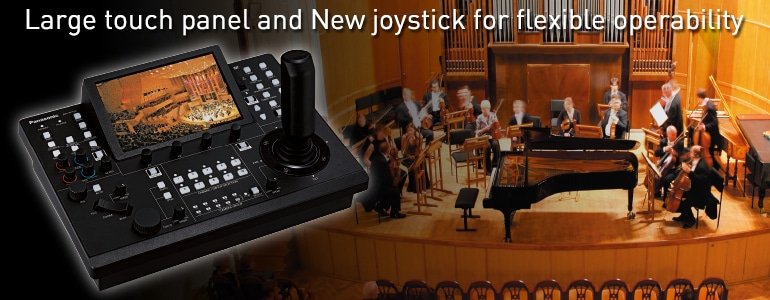AW-RP150GJ

Remote Camera Controller
AW-RP150GJ
An AC adapter is not included with the AW-RP150GJ.
An XLR4 pin 12 V capacity power supply is required to supply the rated power consumption (12 W) of this device.
https://youtu.be/dX13VosUC0k
Intuitive Camera Control for Ease of Use and One-Person Operation
A ZOOM/FOCUS rocker mounted on the joystick manages pan and tilt operations for zoom and focus control and intuitive single-handed operation. The built-in touch display allows for easy and quick operation of all essential camera functions.

Rear View
PoE+* support enables power supply via a LAN cable. Additionally, a dual system GPIO (general purpose input/output) terminal is equipped as standard.

*: Abbreviation of Power over Ethernet Plus.
Touch Panel GUI for High-Quality Operability and Visibility
The touch panel GUI monitor supports camera image display during shooting as well as a variety of operations. The panel is equipped only with buttons that are frequently used, with menu and camera switching operations, indicators and other functions consolidated in the touch panel GUI.
■ Menu screen example

Touch Focus Function Equipped
The focus is quickly aligned to the area touched by tapping the screen. In addition, the Focus in Red display assists with aligning focus by framing the part that is in-focus in red.
■ Focus assist (Focus in Red) screen example

Camera Settings Copied to Multiple Cameras
Scene files, system settings files and other camera settings can be saved on the AW-RP150GJ SD card. These settings can then be copied to multiple cameras via the SD card. This massively reduces on-location setup time when shooting at events with large numbers of cameras.

Smooth Creation of Cropped Images
The cropping function loaded on the AW-UE150W/K can be controlled from the AW-RP150GJ. Images output from the AW-UE150W/K to the monitor can be cropped in three different locations displayed with colored frames (yellow/green/magenta), and fine-tuned with the joystick as you watch. Required images can be cropped precisely and simply.
■ Cropping screen example

*This screen is a monitor output image. *The image is a composite.
Preset Memory for Simple Camera Control
Registration of the camera angle and other remote camera settings allows them to be easily recalled from the touch panel GUI monitor. The movement speed for play back the preset memory can be set by the specified speed or time.
[Supported Presets]
- Pan and tilt position
- Focus position
- White balance settings
- Crop position coordinates
- Zoom position
- Lens aperture (manual iris only)
- Gain
Tracing Memory for Memory and Recall of Camera Operations
The tracing memory function records a series of operation performed for the remote camera. Up to 5 minutes for 10 operations can be memorized for a single camera, and that trajectory can then be reproduced.
[Supported Presets]
- Pan and tilt position
- Focus position
- White balance settings
- Zoom position
- Lens aperture (manual iris only)
- Gain







